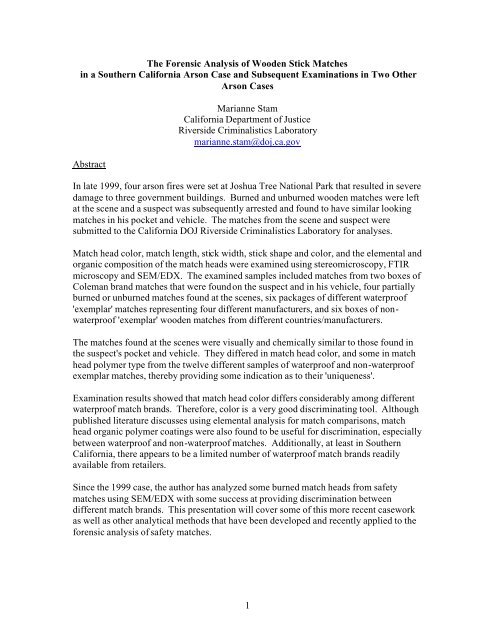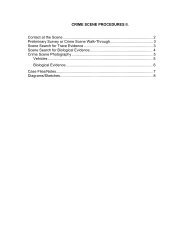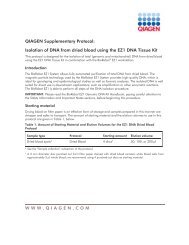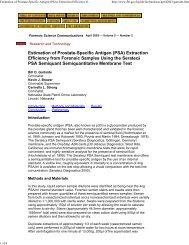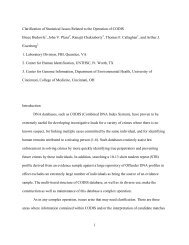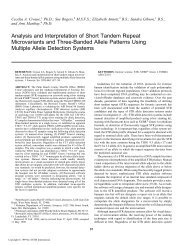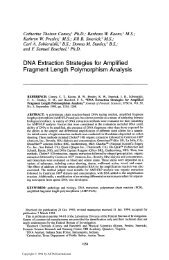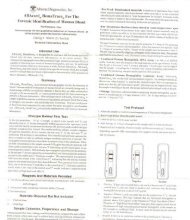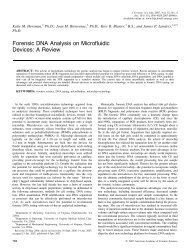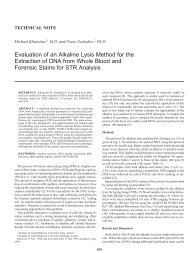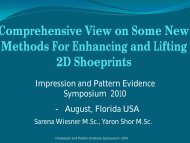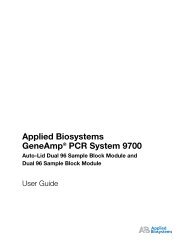The Forensic Analysis of Wooden Stick Matches - Projects at NFSTC ...
The Forensic Analysis of Wooden Stick Matches - Projects at NFSTC ...
The Forensic Analysis of Wooden Stick Matches - Projects at NFSTC ...
You also want an ePaper? Increase the reach of your titles
YUMPU automatically turns print PDFs into web optimized ePapers that Google loves.
<strong>The</strong> <strong>Forensic</strong> <strong>Analysis</strong> <strong>of</strong> <strong>Wooden</strong> <strong>Stick</strong> <strong>M<strong>at</strong>ches</strong>in a Southern California Arson Case and Subsequent Examin<strong>at</strong>ions in Two OtherArson CasesAbstractMarianne StamCalifornia Department <strong>of</strong> JusticeRiverside Criminalistics Labor<strong>at</strong>orymarianne.stam@doj.ca.govIn l<strong>at</strong>e 1999, four arson fires were set <strong>at</strong> Joshua Tree N<strong>at</strong>ional Park th<strong>at</strong> resulted in severedamage to three government buildings. Burned and unburned wooden m<strong>at</strong>ches were left<strong>at</strong> the scene and a suspect was subsequently arrested and found to have similar lookingm<strong>at</strong>ches in his pocket and vehicle. <strong>The</strong> m<strong>at</strong>ches from the scene and suspect weresubmitted to the California DOJ Riverside Criminalistics Labor<strong>at</strong>ory for analyses.M<strong>at</strong>ch head color, m<strong>at</strong>ch length, stick width, stick shape and color, and the elemental andorganic composition <strong>of</strong> the m<strong>at</strong>ch heads were examined using stereomicroscopy, FTIRmicroscopy and SEM/EDX. <strong>The</strong> examined samples included m<strong>at</strong>ches from two boxes <strong>of</strong>Coleman brand m<strong>at</strong>ches th<strong>at</strong> were found on the suspect and in his vehicle, four partiallyburned or unburned m<strong>at</strong>ches found <strong>at</strong> the scenes, six packages <strong>of</strong> different w<strong>at</strong>erpro<strong>of</strong>'exemplar' m<strong>at</strong>ches representing four different manufacturers, and six boxes <strong>of</strong> nonw<strong>at</strong>erpro<strong>of</strong>'exemplar' wooden m<strong>at</strong>ches from different countries/manufacturers.<strong>The</strong> m<strong>at</strong>ches found <strong>at</strong> the scenes were visually and chemically similar to those found inthe suspect's pocket and vehicle. <strong>The</strong>y differed in m<strong>at</strong>ch head color, and some in m<strong>at</strong>chhead polymer type from the twelve different samples <strong>of</strong> w<strong>at</strong>erpro<strong>of</strong> and non-w<strong>at</strong>erpro<strong>of</strong>exemplar m<strong>at</strong>ches, thereby providing some indic<strong>at</strong>ion as to their 'uniqueness'.Examin<strong>at</strong>ion results showed th<strong>at</strong> m<strong>at</strong>ch head color differs considerably among differentw<strong>at</strong>erpro<strong>of</strong> m<strong>at</strong>ch brands. <strong>The</strong>refore, color is a very good discrimin<strong>at</strong>ing tool. Althoughpublished liter<strong>at</strong>ure discusses using elemental analysis for m<strong>at</strong>ch comparisons, m<strong>at</strong>chhead organic polymer co<strong>at</strong>ings were also found to be useful for discrimin<strong>at</strong>ion, especiallybetween w<strong>at</strong>erpro<strong>of</strong> and non-w<strong>at</strong>erpro<strong>of</strong> m<strong>at</strong>ches. Additionally, <strong>at</strong> least in SouthernCalifornia, there appears to be a limited number <strong>of</strong> w<strong>at</strong>erpro<strong>of</strong> m<strong>at</strong>ch brands readilyavailable from retailers.Since the 1999 case, the author has analyzed some burned m<strong>at</strong>ch heads from safetym<strong>at</strong>ches using SEM/EDX with some success <strong>at</strong> providing discrimin<strong>at</strong>ion betweendifferent m<strong>at</strong>ch brands. This present<strong>at</strong>ion will cover some <strong>of</strong> this more recent caseworkas well as other analytical methods th<strong>at</strong> have been developed and recently applied to theforensic analysis <strong>of</strong> safety m<strong>at</strong>ches.1
Part I: 1999 Arson CaseIntroduction:On December 10, 1999, four arson fires severely damaged three government buildings <strong>at</strong>Joshua Tree N<strong>at</strong>ional Park. <strong>Wooden</strong> stick m<strong>at</strong>ches were left <strong>at</strong> the scenes and a suspectwas arrested with boxes <strong>of</strong> wooden m<strong>at</strong>ches in his possession. A N<strong>at</strong>ional Park Serviceinvestig<strong>at</strong>or requested forensic examin<strong>at</strong>ions and comparisons <strong>of</strong> the m<strong>at</strong>ches left <strong>at</strong> thescenes and the m<strong>at</strong>ches found in the suspect’s possession. <strong>The</strong> investig<strong>at</strong>or also went tovarious stores throughout the gre<strong>at</strong>er Los Angeles area to obtain additional m<strong>at</strong>chexemplars for comparisons and found only a limited number th<strong>at</strong> were available.<strong>M<strong>at</strong>ches</strong> are generally <strong>of</strong> two varieties, the ‘strike anywhere’ and the ‘safety’ types.‘Strike anywhere’ m<strong>at</strong>ch heads contain an oxidant such as potassium chlor<strong>at</strong>e mixed withan oxidizable m<strong>at</strong>erial such as sulfur, a higher concentr<strong>at</strong>ion <strong>of</strong> binder m<strong>at</strong>erial such asglue, and inorganic fillers th<strong>at</strong> can include glass, di<strong>at</strong>oms etc…<strong>The</strong> tips contain a largeamount <strong>of</strong> a phosphorous compound, are more readily ignited than the remainder <strong>of</strong> thehead, and they ignite by friction (1,2).<strong>The</strong> ‘safety m<strong>at</strong>ches’ heads contain an oxidizing substance, an easily oxidizable m<strong>at</strong>erialsuch as antimony sulfide, a binder and inorganic fillers. <strong>The</strong>se m<strong>at</strong>ches will only ignitewhen struck on boxes th<strong>at</strong> have striker pads containing red phosphorous, an oxidizingagent, glue, and an abrasive m<strong>at</strong>erial such as ground glass (1,2).<strong>The</strong> binder in m<strong>at</strong>ch heads is usually animal glue. In some humid regions (such asSoutheast Asia) casein or soya protein hydrolys<strong>at</strong>es mixed with polyvinyl acet<strong>at</strong>e areused as the binder to provide gre<strong>at</strong>er humidity resistance; however, these are not‘w<strong>at</strong>erpro<strong>of</strong>’ m<strong>at</strong>ches. <strong>The</strong> humidity resistant binders are not generally used in m<strong>at</strong>chesfrom Europe or North America. Actual w<strong>at</strong>erpro<strong>of</strong> m<strong>at</strong>ches have binders th<strong>at</strong> are usuallynitrocellulose based lacquers (2).Samples for Examin<strong>at</strong>ion:<strong>M<strong>at</strong>ches</strong> from boxes <strong>of</strong> Coleman brand w<strong>at</strong>erpro<strong>of</strong> wooden stick m<strong>at</strong>ches from thesuspect, partially burned or unburned wooden stick m<strong>at</strong>ches from the scenes, six packages<strong>of</strong> different w<strong>at</strong>erpro<strong>of</strong> m<strong>at</strong>ches representing four different manufacturers, and sixboxes <strong>of</strong> non-w<strong>at</strong>erpro<strong>of</strong> stick m<strong>at</strong>ches from different countries/manufacturers wereexamined and compared (Figures 1-4).Figure 1: <strong>M<strong>at</strong>ches</strong> from Scenes and Suspect2
Figure 2: Exemplar W<strong>at</strong>erpro<strong>of</strong> <strong>M<strong>at</strong>ches</strong>Figure 3: Brands <strong>of</strong> W<strong>at</strong>erpro<strong>of</strong> <strong>M<strong>at</strong>ches</strong> from Different Storesin the Gre<strong>at</strong>er Los Angeles AreaFigure 4: Exemplar Non-w<strong>at</strong>erpro<strong>of</strong> <strong>M<strong>at</strong>ches</strong>3
Methods <strong>of</strong> <strong>Analysis</strong>:M<strong>at</strong>ch head color, m<strong>at</strong>ch length, stick width, stick shape, stick color, and m<strong>at</strong>ch headorganic and inorganic components were examined using stereomicroscopy, FourierTransform Infrared Microspectroscopy (FTIR), and Scanning Electron Microscopy -Energy Dispersive X-ray (SEM/EDX) analysis respectively.Samples were prepared for FTIR analyses by removing thin films <strong>of</strong> binder m<strong>at</strong>erial(Figure 5) from the m<strong>at</strong>ch heads using a razor blade. <strong>The</strong> films were placed on a bariumfluoride salt pl<strong>at</strong>e and analyzed using an IrPlan microscope <strong>at</strong>tached to a Nicolet 5DXCinfrared spectrometer. Films from each m<strong>at</strong>ch head were analyzed more than once, andfilms from multiple m<strong>at</strong>ch heads from each box were also examined.Figure 5: Thin Film on Coleman Brand W<strong>at</strong>erpro<strong>of</strong> M<strong>at</strong>ch Head(Olympus SZ 40 stereomic roscope ?40X)For SEM/EDX analyses a portion <strong>of</strong> the m<strong>at</strong>ch head in each sample was cut using a razorblade and placed on carbon tape <strong>at</strong>op an aluminum sample holder. <strong>The</strong> m<strong>at</strong>ch heads wereanalyzed using a Hitachi S520 SEM with a Tracor Northern 5500 EDX detector.Examin<strong>at</strong>ion Results:M<strong>at</strong>ch head colors, m<strong>at</strong>ch lengths, stick colors, widths and shapes for the crime scenem<strong>at</strong>ches and those from the suspect were similar (Tables 1A, 1B). <strong>The</strong> m<strong>at</strong>ch head colorsand lengths <strong>of</strong> the different w<strong>at</strong>erpro<strong>of</strong> m<strong>at</strong>ch brands differed significantly (Table 1C).<strong>The</strong> films on the Coleman brand m<strong>at</strong>ches from the suspect and the thin films on them<strong>at</strong>ches from the scene were similar in chemistry and they consisted <strong>of</strong> a predominantlynitrocellulose based polymer (Figure 6).4
Figure 6: FTIR Spectra <strong>of</strong> Thin Film on M<strong>at</strong>ch heads from Suspect (#25C) andCrime Scene (#12)<strong>The</strong> clear films on some <strong>of</strong> the m<strong>at</strong>ch heads in the other brands <strong>of</strong> w<strong>at</strong>erpro<strong>of</strong> m<strong>at</strong>chesdiffered in chemistry from the Coleman brand m<strong>at</strong>ches (Figure 7). Some <strong>of</strong> these m<strong>at</strong>chheads also had a similar binder chemistry to the Coleman brand.Figure 7: FTIR Spectra <strong>of</strong> Clear Films from M<strong>at</strong>ch Heads in REI and StansportW<strong>at</strong>erpro<strong>of</strong> <strong>M<strong>at</strong>ches</strong>5
<strong>The</strong> clear films on the non-w<strong>at</strong>erpro<strong>of</strong> m<strong>at</strong>ches all differed in their FTIR spectra from theColeman and other brands <strong>of</strong> w<strong>at</strong>erpro<strong>of</strong> m<strong>at</strong>ches (Figure 8).Figure 8: FTIR Spectra <strong>of</strong> Clear Films in Two Non-w<strong>at</strong>erpro<strong>of</strong> <strong>M<strong>at</strong>ches</strong><strong>The</strong> m<strong>at</strong>ches from the suspect and from the crime scenes were also similar in elementalcontent and they contained major elements Cl, S, K, Si, and moder<strong>at</strong>e to minor elementsFe, Cr, Cu and Zn (Figure 9).Figure 9: EDX Spectra <strong>of</strong> <strong>M<strong>at</strong>ches</strong> from Suspect (25B) andfrom Crime Scene (12)6
<strong>The</strong> following tables (Tables 1A-1D) summarize the findings from the analyses <strong>of</strong> them<strong>at</strong>ches from the crime scenes, the m<strong>at</strong>ches from the suspect, and the exemplar m<strong>at</strong>ches.ATable 1BItemNumber3435363738Brand NameCEXEMPLAR WATERPROOF MATCHESCountry <strong>of</strong>OriginM<strong>at</strong>chHeadColorTexsportSafety China RedCoghlan’sSafety Philippines GreenCoghlan’sWind andW<strong>at</strong>erpro<strong>of</strong>SafetyREI Storm -pro<strong>of</strong>HungaryIndiaRedBrownandOrangeLength(cm)3.8to4.04.3to4.44.3to4.4Stansport -W<strong>at</strong>erpro<strong>of</strong> China Brown 4.3<strong>Stick</strong>Width (mmx mm)/Shape2 x 2Square2 x 2Square2 x 2Square7.2 2 x 2Square2 x 2SquareM<strong>at</strong>ch HeadCo<strong>at</strong>ing –Main PolymerNitrocelluloseNitrocelluloseNitrocellulose(Differs in minorcomponent fromother we<strong>at</strong>herpro<strong>of</strong>m<strong>at</strong>ches)Orthopolyester(Alkyd)Vinyl Acet<strong>at</strong>eand Amide39StansportSafetyW<strong>at</strong>erpro<strong>of</strong>HungaryRed4.3to4.42 x 2Square Same as 367
DConclusions:<strong>The</strong> m<strong>at</strong>ches found <strong>at</strong> the crime scenes were similar visually and chemically to thosefrom the suspect. <strong>The</strong>refore the m<strong>at</strong>ches <strong>at</strong> the scenes could have come from the samesource as those from the suspect.M<strong>at</strong>ch head color differs considerably among different w<strong>at</strong>erpro<strong>of</strong> m<strong>at</strong>ch brands and istherefore a very good discrimin<strong>at</strong>ing tool. Polymer co<strong>at</strong>ings on m<strong>at</strong>ch heads also arevariable – especially between non-w<strong>at</strong>erpro<strong>of</strong> and w<strong>at</strong>erpro<strong>of</strong> m<strong>at</strong>ches. <strong>The</strong>refore,polymer co<strong>at</strong>ings can provide additional inform<strong>at</strong>ion and discrimin<strong>at</strong>ion between woodenstick m<strong>at</strong>ches.W<strong>at</strong>erpro<strong>of</strong> m<strong>at</strong>ches are highly variable and also somewh<strong>at</strong> limited in the number <strong>of</strong>available brands in Southern California (and also possibly in other areas <strong>of</strong> the country).Part II: Additional Casework Applic<strong>at</strong>ions:Since 1999, more wooden stick m<strong>at</strong>ches have been analyzed in two additional arsoncases. In one <strong>of</strong> these cases, ‘strike-on-box’, burned and unburned wooden stick m<strong>at</strong>chesrepresenting nine different m<strong>at</strong>ch head colors and various countries <strong>of</strong> origin/manufacturers were analyzed for their elemental content. Portions <strong>of</strong> the m<strong>at</strong>ch heads <strong>of</strong>each sample were placed on carbon tape <strong>at</strong>op an aluminum sample holder and analyzedusing an FEI Quanta 400 variable pressure SEM with an EDAX EDX detector. <strong>The</strong>elemental compositions <strong>of</strong> the burned and unburned m<strong>at</strong>ch heads are depicted in Table 2:8
ManufacturerAnd/orCountryUnited M<strong>at</strong>ch/JapanBelgiumJapanAdm<strong>at</strong>ch/JapanCanadaDiamond (n=250)/USADiamond (n=32)/USALastar/JapanPenley/ChinaDiamond/USAAtlasUnknownUnknownTable 2: Elemental Compositions <strong>of</strong> Burned and Unburned <strong>Wooden</strong> <strong>Stick</strong><strong>M<strong>at</strong>ches</strong> from Various Manufacturers/Countries <strong>of</strong> Origin (Case #1)UnburnedM<strong>at</strong> ch head Color Si K Cl P S Ca Al Ti Zn Mg Cr Na Fe CuTurquoiseBlueBluePurpleGreenRedRedRedCoral RedPink-RedSilverWhiteWhiteWhite???????????????????????????????????????????????????????????? ?????????????????????? ? **????????????? ?? ?? *??? ?? *??? ??? ??? ????? ??? ??**?????? ?????????????? ????**?????????? ?*????****?? * *** *** * * *??????????????**???????????? ???**?? *??**?? *??*********?? Elements present in unburned m<strong>at</strong>ch heads? Elements present in burned m<strong>at</strong>ch heads* Elements possibly present in burned m<strong>at</strong>ch heads* Elements possibly present in unburned m<strong>at</strong>ch heads? Elements not presentOf the 14 elements detected in one or more <strong>of</strong> the samples, Cu and Cr were the rarest, Si,K, Cl, Al, S, and Ca were the most common, P was mostly in the burned m<strong>at</strong>ch heads,and Ti, Zn, and Mg were in about half <strong>of</strong> the samples. Fe was present in easily detectableamounts in only a few samples, and Na may be present in more samples, but its elementalpeaks may be obscured by the Zn’s peaks. <strong>The</strong> elemental results are similar to those <strong>of</strong>Andrasko(3), and Gl<strong>at</strong>tstein, et.al.(4).<strong>The</strong>re appeared to be no particular correl<strong>at</strong>ion between m<strong>at</strong>ch head color and elementalcomposition, and most elements present before the m<strong>at</strong>ch heads were burned weredetectable after burning.From this limited study, it appears th<strong>at</strong> the presence <strong>of</strong> Cu or Cr in wooden stick m<strong>at</strong>chheads could be significant for distinguishing m<strong>at</strong>ches from different sources. Ti, Zn, Mgand possibly Fe also appear to be rel<strong>at</strong>ively significant for distinguishing differentm<strong>at</strong>ches. Cu, Cr, Ti, Zn, Mg and possibly Fe could be especially useful for9
distinguishing burned m<strong>at</strong>ch heads when original m<strong>at</strong>ch head color is not present inburned samples.In the second arson case, there were multiple arson scenes and a large number <strong>of</strong> burnedand unburned wooden stick m<strong>at</strong>ches in several evidentiary items. <strong>The</strong>se m<strong>at</strong>ches wereexamined and c<strong>at</strong>egorized based on their morphological fe<strong>at</strong>ures such as m<strong>at</strong>ch headcolors (when present), shapes and morphologies <strong>of</strong> burned and unburned m<strong>at</strong>ch heads,lengths <strong>of</strong> m<strong>at</strong>ches, stick color and shape (when possible). Samples were also preparedand analyzed for their elemental content as above. <strong>The</strong> results are in Table 3.Table 3: Table <strong>of</strong> Distinguishing Fe<strong>at</strong>ures for Different Groups <strong>of</strong> <strong>Wooden</strong> <strong>Stick</strong><strong>M<strong>at</strong>ches</strong> in Case Example #2Group #M<strong>at</strong>ch Head ColorElemental Characteristics -Significant DistinguishingFe<strong>at</strong>ures/Rel<strong>at</strong>ive Elemental Levels(b=burned m<strong>at</strong>ch head)(ub= unburned m<strong>at</strong>ch head)1 Red- Ca moder<strong>at</strong>e (b)- Si large (ub)2 Red with white tips3 Red**(heads partially burned)- Ca, Zn, P moder<strong>at</strong>e (b)- Si large (ub)- Zn, P, Ca, S moder<strong>at</strong>e (ub)- Ca, Zn moder<strong>at</strong>e4 Red - Do not contain Zn, Mg, Cr, or Fe5Burned but with yellowresidue- Ti moder<strong>at</strong>e- All contain Cr- Do not contain Ca, Zn, or Fe, andlittle to no Mg.6 Burned – no original color - Does not contain Mg or Cr7 Burned – no original color - Contains Cr and no Fe8 Pink-red - Does not contain Ti10
<strong>The</strong>re were eight different ‘groups’ <strong>of</strong> m<strong>at</strong>ches th<strong>at</strong> were defined by their morphologicalcharacteristics and the elemental contents <strong>of</strong> their unburned and/or burned m<strong>at</strong>ch heads.<strong>M<strong>at</strong>ches</strong> with similar colored heads were distinguishable when analyzed for elementalcomposition. Furthermore, the color and morphology <strong>of</strong> the burned residue on the m<strong>at</strong>chheads was also useful for distinguishing m<strong>at</strong>ches in Group 5 from m<strong>at</strong>ches in the othergroups.Part III. Newer Developments:Farmer, et. al. recently explored the use <strong>of</strong> Isotope R<strong>at</strong>io Mass Spectrometry (IRMS) <strong>of</strong>the wood in the sticks <strong>of</strong> wooden m<strong>at</strong>ches to “determine whether IRMS could be used toprovide any additional inform<strong>at</strong>ion about mass-produced safety m<strong>at</strong>ches found <strong>at</strong> crimescenes” (5, 6).<strong>The</strong>se newer studies, combined with the traditional methods for the analysis <strong>of</strong> woodenstick m<strong>at</strong>ches in forensic science, allow for not only the differenti<strong>at</strong>ion <strong>of</strong> the m<strong>at</strong>chesbased upon the m<strong>at</strong>ch head compositions, but also for a more sophistic<strong>at</strong>ed method <strong>of</strong>possibly determining whether an individual m<strong>at</strong>ch came from a particular box ormanufacturer.11
References:1. Kirk, PL. Fire Investig<strong>at</strong>ion. John Wiley and Sons, NY, 1969.2. Cox, M. Personal Communic<strong>at</strong>ion via e -mail, 2000.3. Andrasko, J., “Identific<strong>at</strong>ion <strong>of</strong> Burnt <strong>M<strong>at</strong>ches</strong> by Scanning ElectronMicroscopy”, Journal <strong>of</strong> <strong>Forensic</strong> Sciences, Vol. 23, 1978, pp. 637-642.4. Gl<strong>at</strong>tstein, B, Landau, E and Zeichner, A. “Identific<strong>at</strong>ion <strong>of</strong> M<strong>at</strong>ch HeadResidues in Post-Explosion Debris, Journal <strong>of</strong> <strong>Forensic</strong> Sciences, Vol. 25, 1991,pp. 1360-1367.5. Farmer, NL, Meier-Augenstein, W and Kalin, RM., “Stable Isotope <strong>Analysis</strong> <strong>of</strong>Safety <strong>M<strong>at</strong>ches</strong> Using Isotope R<strong>at</strong>io Mass Spectrometry - A <strong>Forensic</strong> Case Study,Rapid Commun. Mass Spectrom., Vol. 19, 2005, pp. 3182-3186.6. Farmer, NL, Meier-Augenstein, W and Kalin, RM, “Isotope <strong>Analysis</strong> <strong>of</strong> Safety<strong>M<strong>at</strong>ches</strong>, Poster Present<strong>at</strong>ion, obtained from the Internet, 2006.12


